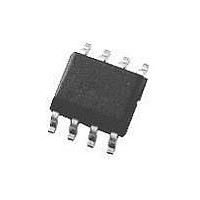EL5192ACS Intersil, EL5192ACS Datasheet - Page 15

EL5192ACS
Manufacturer Part Number
EL5192ACS
Description
IC, VIDEO AMPLIFIER, SGL, 600MHZ, SOIC-8
Manufacturer
Intersil
Datasheet
1.EL5192CWZ-T7.pdf
(20 pages)
Specifications of EL5192ACS
Gain Bandwidth
600MHz
Supply Voltage Range
5V To 10V
Slew Rate
2800V/µs
No. Of Amplifiers
1
Output Current
120mA
Amplifier Output
Single Ended
Operating Temperature Range
-40°C To +85°C
Lead Free Status / RoHS Status
Contains lead / RoHS non-compliant
Disable/Power-Down
The EL5192A amplifier can be disabled placing its output in
a high impedance state. When disabled, the amplifier supply
current is reduced to < 150µA. The EL5192A is disabled
when its CE pin is pulled up to within 1V of the positive
supply. Similarly, the amplifier is enabled by floating or
pulling its CE pin to at least 3V below the positive supply. For
±5V supply, this means that an EL5192A amplifier will be
enabled when CE is 2V or less, and disabled when CE is
above 4V. Although the logic levels are not standard TTL,
this choice of logic voltages allows the EL5192A to be
enabled by tying CE to ground, even in 5V single supply
applications. The CE pin can be driven from CMOS outputs.
Capacitance at the Inverting Input
Any manufacturer’s high-speed voltage- or current-feedback
amplifier can be affected by stray capacitance at the
inverting input. For inverting gains, this parasitic capacitance
has little effect because the inverting input is a virtual
ground, but for non-inverting gains, this capacitance (in
conjunction with the feedback and gain resistors) creates a
pole in the feedback path of the amplifier. This pole, if low
enough in frequency, has the same destabilizing effect as a
zero in the forward open-loop response. The use of large-
value feedback and gain resistors exacerbates the problem
by further lowering the pole frequency (increasing the
possibility of oscillation.)
The EL5192 has been optimized with a 375Ω feedback
resistor. With the high bandwidth of these amplifiers, these
resistor values might cause stability problems when
combined with parasitic capacitance, thus ground plane is
not recommended around the inverting input pin of the
amplifier.
Feedback Resistor Values
The EL5192 has been designed and specified at a gain of +2
with R
gives 300MHz of -3dB bandwidth at A
peaking. With A
bandwidth with 1dB of peaking. Since the EL5192 is a
current-feedback amplifier, it is also possible to change the
value of R
Frequency Response for Various R
peaking can be easily modified by varying the value of the
feedback resistor.
Because the EL5192 is a current-feedback amplifier, its
gain-bandwidth product is not a constant for different closed-
loop gains. This feature actually allows the EL5192 to
maintain about the same -3dB bandwidth. As gain is
increased, bandwidth decreases slightly while stability
increases. Since the loop stability is improving with higher
closed-loop gains, it becomes possible to reduce the value
of R
resulting in only a slight loss of bandwidth with increased
closed-loop gain.
F
below the specified 375Ω and still retain stability,
F
approximately 375Ω. This value of feedback resistor
F
to get more bandwidth. As seen in the curve of
V
=-2, an R
F
of 375Ω gives 275MHz of
15
F
and R
V
=2 with 2dB of
G
, bandwidth and
EL5192, EL5192A
Supply Voltage Range and Single-Supply
Operation
The EL5192 has been designed to operate with supply
voltages having a span of greater than 5V and less than 10V.
In practical terms, this means that the EL5192 will operate
on dual supplies ranging from ±2.5V to ±5V. With single-
supply, the EL5192 will operate from 5V to 10V.
As supply voltages continue to decrease, it becomes
necessary to provide input and output voltage ranges that
can get as close as possible to the supply voltages. The
EL5192 has an input range which extends to within 2V of
either supply. So, for example, on ±5V supplies, the EL5192
has an input range which spans ±3V. The output range of the
EL5192 is also quite large, extending to within 1V of the
supply rail. On a ±5V supply, the output is therefore capable
of swinging from -4V to +4V. Single-supply output range is
larger because of the increased negative swing due to the
external pull-down resistor to ground.
Video Performance
For good video performance, an amplifier is required to
maintain the same output impedance and the same
frequency response as DC levels are changed at the output.
This is especially difficult when driving a standard video load
of 150Ω, because of the change in output current with DC
level. Previously, good differential gain could only be
achieved by running high idle currents through the output
transistors (to reduce variations in output impedance.)
These currents were typically comparable to the entire 6mA
supply current of each EL5192 amplifier. Special circuitry
has been incorporated in the EL5192 to reduce the variation
of output impedance with current output. This results in dG
and dP specifications of 0.015% and 0.04°, while driving
150Ω at a gain of 2.
Video performance has also been measured with a 500Ω
load at a gain of +1. Under these conditions, the EL5192 has
dG and dP specifications of 0.03% and 0.05°, respectively.
Output Drive Capability
In spite of its low 6mA of supply current, the EL5192 is
capable of providing a minimum of ±95mA of output current.
With a minimum of ±95mA of output drive, the EL5192 is
capable of driving 50Ω loads to both rails, making it an
excellent choice for driving isolation transformers in
telecommunications applications.
Driving Cables and Capacitive Loads
When used as a cable driver, double termination is always
recommended for reflection-free performance. For those
applications, the back-termination series resistor will
decouple the EL5192 from the cable and allow extensive
capacitive drive. However, other applications may have high
capacitive loads without a back-termination resistor. In these
applications, a small series resistor (usually between 5Ω and
50Ω) can be placed in series with the output to eliminate
May 16, 2007
FN7181.3












